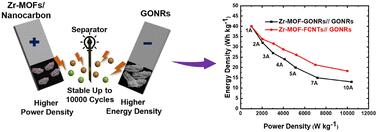Our official English website, www.x-mol.net, welcomes your
feedback! (Note: you will need to create a separate account there.)
Zr-MOF composites with zipped and unzipped carbon nanotubes for high-performance electrochemical supercapacitors
Nanoscale ( IF 5.8 ) Pub Date : 2024-11-20 , DOI: 10.1039/d4nr03926b Asmaa R. Heiba, M. O. Abdel-Salam, Taeho Yoon, Ehab El Sawy
Nanoscale ( IF 5.8 ) Pub Date : 2024-11-20 , DOI: 10.1039/d4nr03926b Asmaa R. Heiba, M. O. Abdel-Salam, Taeho Yoon, Ehab El Sawy

|
Metal–organic frameworks (MOFs) have gained considerable interest as crystalline porous materials with notable characteristics, such as high surface area and excellent electrochemical performance, particularly in supercapacitor applications. The combination of MOFs with various nanocarbon materials further enhances their performance. This study investigated the combination of zirconium-based MOFs (Zr-MOFs) with graphene oxide nanoribbons (GONRs), zipped carbon nanotubes, and functionalized carbon nanotubes (FCNTs) to fabricate composites with elevated electrical conductivity, adjustable surface area, chemical robustness, mechanical strength, and customizable attributes for specific applications. Zr-MOFs exhibit remarkable capacitance, making them promising electrode materials for supercapacitors. GONRs and FCNTs have recently emerged as focal materials owing to their unique properties, which make them promising materials for electrochemical energy storage devices. A thorough investigation of the supercapacitive behavior of GONRs, FCNTs, Zr-MOFs, Zr-MOFs/FCNTs, and Zr-MOFs/GONRs in 1 M H2SO4 using different evaluation systems (three- and two-electrode systems) revealed a significant enhancement in the capacitance of Zr-MOFs after the introduction of GONRs and FCNTs. Employing Zr-MOF/GONR and Zr-MOF/FCNT composites as positive electrodes and GONRs as negative electrodes in two-electrode measurements demonstrated remarkable cycling stability by retaining their specific capacitances (Cs) even after 10 000 consecutive charge/discharge cycles at a high current density of 10 A g−1. Moreover, they feature a broad potential window of 1.7 V in the three-electrode system. This extends to 2 V in the two-electrode system, achieving high Cs. This highlights the remarkable electrochemical performance of the Zr-MOF/GONR and Zr-MOF/FCNT composites, offering a compelling approach for energy storage applications.
中文翻译:

用于高性能电化学超级电容器的 Zr-MOF 复合材料与拉链和解压缩碳纳米管
金属有机框架 (MOF) 作为具有显着特性的晶体多孔材料而受到广泛关注,例如高表面积和出色的电化学性能,尤其是在超级电容器应用中。MOF 与各种纳米碳材料的结合进一步增强了它们的性能。本研究研究了锆基 MOF (Zr-MOF) 与氧化石墨烯纳米带 (GONR)、拉链碳纳米管和功能化碳纳米管 (FCNT) 的组合,以制造具有更高导电性、可调节表面积、化学稳健性、机械强度和特定应用的可定制属性的复合材料。Zr-MOF 表现出显着的电容,使其成为超级电容器的有前途的电极材料。GONR 和 FCNT 由于其独特的性能而最近成为焦点材料,这使它们成为电化学储能器件的有前途的材料。使用不同的评估系统(三电极和双电极系统)对 GONR、FCNTs、Zr-MOFs、Zr-MOFs/FCNTs和 Zr-MOFs/GONRs 在 1 m H2SO4 中的超电容行为进行了深入研究,结果显示,在引入 GONRs 和 FCNTs 后,Zr-MOF 的电容显著增强。在双电极测量中采用 Zr-MOF/GONR 和 Zr-MOF/FCNT 复合材料作为正电极,使用 GONR 作为负电极即使在 10 A g-1 的高电流密度下连续充电/放电 10 000 次后,仍保持其比电容 (Cs),表现出卓越的循环稳定性。此外,它们具有 1 的广泛潜在窗口。7 V,采用三电极系统。这在双电极系统中扩展到 2 V,实现了高 Cs。这凸显了 Zr-MOF/GONR 和 Zr-MOF/FCNT 复合材料卓越的电化学性能,为储能应用提供了一种引人注目的方法。
更新日期:2024-11-20
中文翻译:

用于高性能电化学超级电容器的 Zr-MOF 复合材料与拉链和解压缩碳纳米管
金属有机框架 (MOF) 作为具有显着特性的晶体多孔材料而受到广泛关注,例如高表面积和出色的电化学性能,尤其是在超级电容器应用中。MOF 与各种纳米碳材料的结合进一步增强了它们的性能。本研究研究了锆基 MOF (Zr-MOF) 与氧化石墨烯纳米带 (GONR)、拉链碳纳米管和功能化碳纳米管 (FCNT) 的组合,以制造具有更高导电性、可调节表面积、化学稳健性、机械强度和特定应用的可定制属性的复合材料。Zr-MOF 表现出显着的电容,使其成为超级电容器的有前途的电极材料。GONR 和 FCNT 由于其独特的性能而最近成为焦点材料,这使它们成为电化学储能器件的有前途的材料。使用不同的评估系统(三电极和双电极系统)对 GONR、FCNTs、Zr-MOFs、Zr-MOFs/FCNTs和 Zr-MOFs/GONRs 在 1 m H2SO4 中的超电容行为进行了深入研究,结果显示,在引入 GONRs 和 FCNTs 后,Zr-MOF 的电容显著增强。在双电极测量中采用 Zr-MOF/GONR 和 Zr-MOF/FCNT 复合材料作为正电极,使用 GONR 作为负电极即使在 10 A g-1 的高电流密度下连续充电/放电 10 000 次后,仍保持其比电容 (Cs),表现出卓越的循环稳定性。此外,它们具有 1 的广泛潜在窗口。7 V,采用三电极系统。这在双电极系统中扩展到 2 V,实现了高 Cs。这凸显了 Zr-MOF/GONR 和 Zr-MOF/FCNT 复合材料卓越的电化学性能,为储能应用提供了一种引人注目的方法。































 京公网安备 11010802027423号
京公网安备 11010802027423号